
River dolphins aren’t just fascinating because of their habitat. From their physical characteristics to their behaviors and conservation challenges, there’s a lot to discover. They remind us that nature is full of surprises, even in the waterways that flow through our towns. Let’s dive into ten fascinating facts that highlight what makes river dolphins so special!
1. Unique Species of River Dolphins
River dolphins belong to several species, each specially adapted to their specific watery homes. The Amazon river dolphin, or *Inia geoffrensis*, is perhaps the most well-known. Its pink coloration makes it stand out, which is pretty amazing! The *Boto*—as it’s often called—can be found throughout the Amazon Basin, where it swims in both slow and fast-moving waters.
Then we have the Yangtze river dolphin, or *Lipotes vexillifer*. Sadly, this species is critically endangered and may even be extinct, but it’s a perfect example of how unique river dolphins can be. They were known for their long, streamlined bodies and the ability to navigate through the complex river systems of China.
You might also encounter the Ganges river dolphin, which thrives in the rivers of India and Bangladesh. It features a more robust body and is often seen swimming in turbid waters, relying on echolocation to find its way around. This diversity among river dolphins is one of the many reasons they’re so fascinating!
2. How Do They See Underwater?
You might be wondering how river dolphins can thrive in murky waters where visibility is low. Here’s the thing: they’ve evolved amazing adaptations! River dolphins are almost blind in the traditional sense. Instead of relying heavily on their eyesight, they use echolocation. Picture them sending out sound waves and listening for the echoes that bounce back. This allows them to “see” their surroundings, even in muddy waters.
Imagine trying to navigate through a room filled with fog. If you made a sound and heard it bounce off the walls, you’d have a pretty good idea of where everything is, right? That’s exactly how river dolphins operate! They produce clicks and whistles that travel through the water, helping them locate fish and even avoid obstacles. It’s a fascinating way to interact with their environment and is an incredible example of nature’s ingenuity!
3. Their Diet is a Mixed Bag
So, what do river dolphins eat? Their diet is quite varied and depends on their location. They primarily feast on fish, including catfish, tetras, and prawns. In some regions, they’ll hunt smaller mammals or even crustaceans. Since they swim in different types of waters, they’ve adapted their hunting skills to target available prey.
What’s interesting is how they often work alone or in small groups to catch their meals. Unlike ocean dolphins, which sometimes hunt in large pods, river dolphins seem to enjoy a more solitary lifestyle, likely due to the river environment. This means they need to be clever and resourceful to find food. You can picture them stealthily navigating through the water, using that powerful echolocation to pinpoint their dinner!
4. They Have a Unique Social Life
River dolphins aren’t the social butterflies of the animal kingdom; they tend to be more solitary creatures. However, they do form loose social groups, especially when it comes to mating or caring for young. It’s like having a few close friends rather than a large social circle.
When they give birth, mother river dolphins are incredibly devoted. After a long gestation period of about 10-11 months, a mother usually has a single calf. The calf stays with its mother for several years, learning the ropes of survival. You might say that this relationship highlights a strong bond, as both mother and calf navigate their home waters together.
5. A Distinctive Appearance
River dolphins are pretty easy to recognize, thanks to their unique looks. They often have long, slender bodies with a rounded forehead. One of the most eye-catching features is their skin, which can be a shade of grey, but some species, like the Amazon river dolphin, can appear pink!
This rosy hue isn’t just for show; it’s believed to be a result of their blood vessels being close to the surface of their skin. You can think of it as nature’s own camouflage. This coloration helps them blend into the muddy waters of the river, making it easier to hide from predators while also helping them track other river dolphins.
6. Conservation Challenges
Unfortunately, river dolphins face many challenges that threaten their survival. Habitat loss is a significant issue, often caused by dam construction, pollution, and fishing practices. Imagine living in a home that’s slowly being taken away—this is the reality for these aquatic mammals.
Pollution in the rivers they inhabit can also pose severe health risks. Contaminants can affect their food supply, making it harder for them to thrive. In some areas, they’re caught in fishing nets accidentally, leading to injury or death. Conservation efforts are essential to protect these gentle creatures by creating safe environments and promoting awareness.
7. They’re Highly Intelligent
River dolphins are known for their intelligence, much like their ocean-dwelling cousins. Their ability to use echolocation for hunting shows their problem-solving skills. Playfulness is another sign of intelligence; you might see them surfacing, leaping, or even playing with objects they find in the water.
Some researchers believe that river dolphins might have complex communication systems, although it’s still a topic of study. How amazing would it be to translate their clicks and whistles into a language we could understand? Their social behaviors and playful tendencies highlight that they’re more than just cute animals; they’re intelligent beings navigating their world.
8. Legends and Cultural Significance
Throughout the cultures surrounding their river habitats, river dolphins often hold special significance. For example, in the Amazon, they are celebrated in myths. Many people view them as mystical creatures with protective qualities. Stories sometimes tell of dolphins transforming into humans, engaging with locals, or even saving them from danger.
Such tales emphasize the river dolphin’s importance in local folklore and culture. They remind us of the deep connection humans can have with nature and the respect these creatures deserve. These legends help foster a sense of wonder and highlight the need to protect these animals and their environments.
9. The Importance of River Ecosystems
River dolphins play a vital role in their ecosystems. As predators, they help maintain fish populations, contributing to a balanced aquatic environment. When you think about it, every creature, big or small, plays a part in keeping nature in harmony.
Healthy river ecosystems benefit not only the dolphins but also other wildlife and even local communities. They help filter waters, provide habitats, and ensure the overall health of the environment. Protecting river dolphins means protecting the intricate web of life in the rivers they call home.
10. What You Can Do to Help
Caring for river dolphins and their habitats might seem daunting, but there are simple ways you can contribute. Supporting conservation organizations focused on freshwater ecosystems is a great start. You might consider educating yourself and others about the challenges these dolphins face. Awareness is a powerful tool!
Choosing sustainable seafood, reducing plastic use, and being mindful of water pollution can all make a difference. Each small action adds up and contributes to creating a healthier environment for river dolphins and countless other species. Together, we can help ensure that these incredible creatures continue to thrive in their watery homes.
In conclusion, river dolphins are remarkable animals with unique traits and significant roles in their ecosystems. Understanding more about them not only enriches our knowledge but also fosters a sense of responsibility to protect these gentle giants of the river. Whether by sharing what you’ve learned or taking steps to reduce pollution, every little effort counts.

